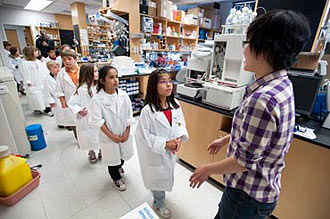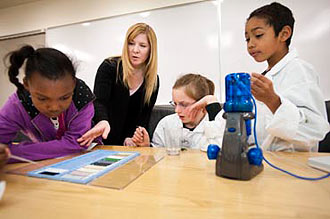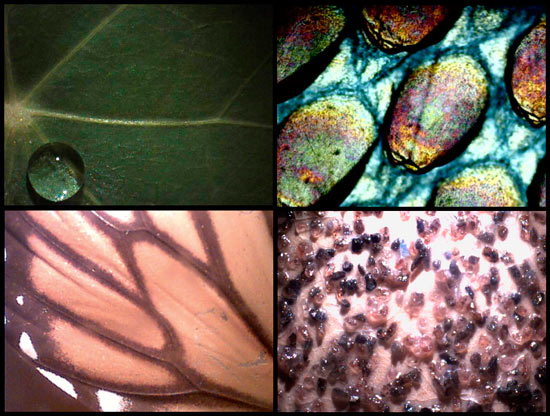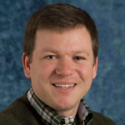It’s a small world (for small people) after all
Lab-coated and goggled, Troy Dassler’s 15 third graders are itching to power up their digital optical microscopes.

On April 19, 2010, graduate student Jenna Eun leads a group of visiting elementary school students on a tour of Doug Wiebel’s research lab. The students, known as MicroExplorers, were touring several research facilities on campus as part of an after-school science outreach program run in collaboration with the university.
Photo: Jeff Miller
Today’s objects of ocular inquiry are feathers: duck feathers, pheasant feathers and a feather of undetermined origin, dyed to look like an eagle’s plume.
“Most black feathers are iridescent,” whispers nine-year-old Molly Jetzer, an Aldo Leopold Elementary School fourth grader serving, essentially, as Dassler’s teaching assistant for MicroExplorers, an after-school program intended to open up the microscopic universe to very young students. Feathers are also “superhydrophobic,” Dassler’s students are quick to add, slipping into lab jargon to explain why feathers so easily repel water.
The qualities of iridescence and superhydrophobicity stem from microscopic and nano-scale physical structures that make such things as the leaves of plants, feathers and the scales of butterfly wings colorful and waterproof.
The goal of MicroExplorers, the product of a broad University of Wisconsin–Madison collaboration, is to open the world of the very small to the very young. This is possible, asserts UW–Madison biochemistry professor Doug Weibel, because advances in plastic optics and the availability of cheap charge-coupled devices (the microelectronic heart of all digital imaging) have brought inexpensive high-end microscopy within reach of children.

Tracy Puccinelli, a postdoctoral research associate with the Materials Research Science and Engineering Center Interdisciplinary Education Group (MRSEC IEG), works with, left to right, Brianna Floyd, Molly Jetzer and Diego Paulino as the children conduct a nanoscale science experiment.
Photo: Jeff Miller
“The microscope is timeless,” explains Weibel, who has partnered with UW–Madison’s Materials Research Science and Engineering Center and the Center for Biology Education to get microscopes into the hands of very small children. “We’re all visual learners. If you can see something, it’s easier to teach. Seeing reinforces ideas.”
The new, inexpensive generation of microscope has no eyepiece, but is tethered to a laptop computer. Images appear on screen and the MicroExplorers can snap digital still images or take movies. In Dassler’s Leopold Elementary classroom, four of the microscopes, each the size and shape of a large can of beans, are deployed and teams of young students crowd around the microscope to view, describe and characterize different objects.
“You can hit chemistry. You can hit physics. You can hit materials science,” says Weibel.
What’s more, the program serves as a gateway to teaching the scientific method at the earliest age. Dassler’s students, for example, keep notebooks and have learned to make the distinction between observation and opinion. And modeling, a keystone of the scientific method, is infused in the lessons Dassler teaches.

Clockwise from upper left, micrographs show a water droplet on a leaf; shed skin from Coco, an elementary class pet gecko; a butterfly wing pattern; and sandpaper texture.
Funding for the program, which now exists in as many as 17 different after school programs in the Madison area, comes from a conglomerate of funders: the Dreyfus Foundation, the Berbee Technical Education Fund, Dow Corning, the Kiwanis Club, the Capital Times Kids Fund, the National Science Foundation (NSF), the Madison Metropolitan School District’s Aristos Grant Program and, most recently, the Morgridge Center for Research.
The big goal, says Weibel, is to establish an organized network of MicroExplorer nodes in classrooms and after school programs well beyond Madison.
“It’s a bootstrap operation now,” he notes “In a year, we can work with about a thousand kids, but we’d like to have a much bigger footprint.”
The program will indeed grow next year, says Dassler, who spends his summers on the UW–Madison campus as part of NSF-funded Research Experiences for Teachers program that is part of the Materials Research Science and Engineering Center (MRSEC). He says the program will add another teacher in 2011, more than doubling its effect in the Madison area.
The bigger goal, says Weibel, is to package the program so that its reach can be extended to classrooms around the country.
“What is really special about the program with the microscopes and the computers is that the students are using technology as researchers,” says Dassler. “They don’t use the technology to learn about how to use the technology. They use the technology to study the microscopic world and collect data.”
Greta Zenner Petersen, director of education for UW–Madison’s MRSEC, is no stranger to innovative science education programs. She sees MicroExplorers as the new wave in science education, pushing science and technology learning to ever-younger students.
“This is a new frontier,” says Zenner Petersen. “There is a push to get kids hooked at a younger age, but we have to meet them at their level. This program is fantastically successful at what it does.”
Tags: biosciences, education, learning, outreach


